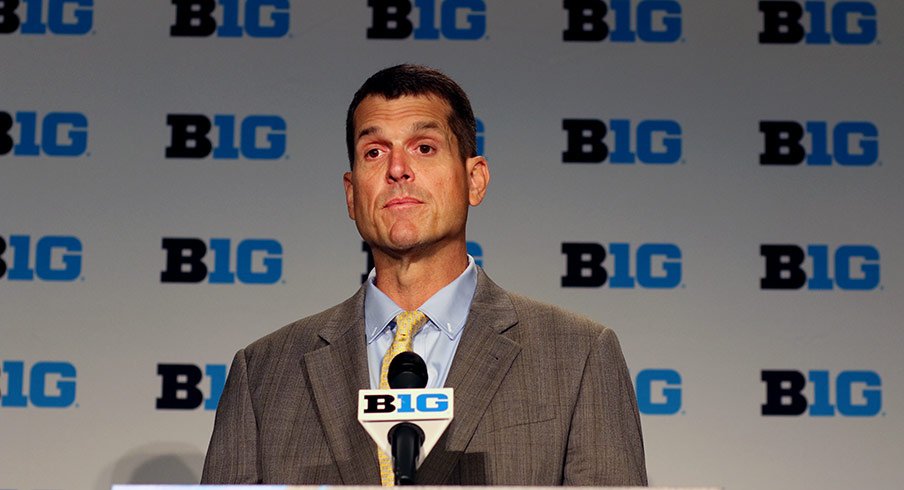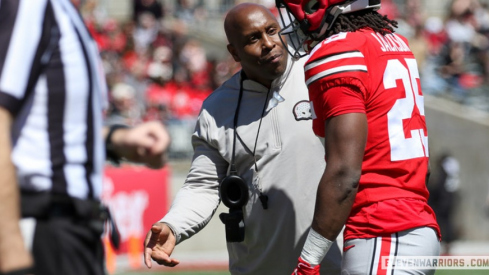College football is a big-money business and it's getting bigger every year. Recruiting, its lifeblood, seems to be getting uglier and uglier; can it be fixed?
At the risk of sounding overly negative, no, I don't think so.
That doesn't mean we, as normally-functioning adults and not just people who see the world only as fans of a certain team or a certain coach, can't try.
For most, the need to stand up and shout that "my team is good, your team is bad" has clouded the minds of people who are, by most accounts, reasonable grown-ups in every other facet of their lives.
Though a vocal group of fans will stomp their feet and surely suggest that the timing of this article is directly related to Jim Harbaugh's most recent jettisoned commitment, it's really just about the kids. When you spend 90 percent of your day talking to teenagers and their parents, coaches and mentors, you are forced to remember that at the end of the day, they still are the reason that the business of football should strive to be better.
There's no surefire way to fix the issues that are so prevalent in today's recruiting world, but there are some things that make sense to try in an effort to make the process a bit easier for both sides to stomach.
Here's a few of the ideas I've collected from talking to a few of the industry's most respected folks. What are your thoughts?
EARLY SIGNING PERIOD
This one seems like a no-brainer and it's without question the one concept that gets the most airtime, thanks in part to its simplicity but also because NCAA basketball already has it implemented.
Currently, Sept. 1 of a prospect's senior year is the date that official, written scholarship offers can be extended, and I believe that's the day that should instead be the start of a two-week long early signing period. When a prospect signs in that period, unlimited contact with him would become permissible, similar to how the rules are currently arranged for midyear financial signees.
Creating an early signing period would provide extra security to recruits and to the schools recruiting them, and it makes a ton of sense.
WRITTEN OFFERS ONLY AND WHENEVER YOU DECIDE TO OFFER IT
After removing that Sept. 1, senior year parameter for a written offer, what makes the most sense is to eliminate the very concept of a "verbal offer" from our lexicon.
If you offer a recruit, period, it's done in a written and therefore official manner. These offers can be extended at any time in a recruit's high school career and–here's a catch–each written offer is good for a six-month period before it expires. If, at the end of that six-month period, School A decides they are still interested and they still have a spot for you, they have to extend another written offer.
No "come to camp and we'll offer" offers, no "we like you and think you should come to our school" offers –– just offers.
OFFICIAL VISITS START IN SPRING OF JUNIOR YEAR
Since official offers are now available at any point, official visits need to be made available to players earlier as well, let's say March 1 of a prospect's junior year in high school.
There would not need to be any additional official visits for the schools, they'd still be limited to 56 a year. Since most schools don't come close to that number in the fall and January (because you know, school, football, crappy weather and all that stuff can get in the way), this would give schools in less-temperate regions of the country a chance to showcase their campus and their locality throughout the year. What if, in lieu of an official visit, a senior used a paid trip to a college camp in the summer evaluation period? There's a few options here.
For the prospects who have received their early, written offers, this would help them get to their school of choice in an official manner before the new September signing period.
On top of the fact that official visits would be allowed earlier in the year, there's also a need for the medical staffs and coaches at the schools being visited to see the players more closely. Every official visit should include a physical evaluation to make sure that college staffs have a chance to see the athlete up close, to make sure both sides are aware of any potentially lingering physical issue.
PAID VISITS FOR JUNIORS
One thing you'll notice if you pay attention to who visits a college campus during the football season is that there are far more sophomores and juniors visiting than there are seniors. The reason for that is simple: by the time a prospect is in his senior year of high school, he's been thoroughly vetted by most coaching staffs and is only visiting because it's an official visit and it's being paid for.
So, if 90 percent or more of the visitors during a football season are juniors or younger, let's extend an opportunity for colleges to bring in a player or two without costing the prospect and their families an arm and a leg.
How about during the fall football season, we allow 10 out-of-state juniors with official offers the chance to have a paid visit, similar to an official visit but only for travel to and from campus.
AN OUT FOR PLAYERS WHO HAVE COACHES LEAVE AFTER SIGNING DAY
Simple solution here to a problem that reared its head last year: if a player commits to a school that has any coach take another job between the February signing day and let's say, March 31, that player can pick another school without penalty.
ALLOW COACHES TO EVALUATE AT THIRD-PARTY CAMPS
One area of recent concern, and one that leads to late "decommitments," is that college coaches who evaluate talent in the spring and early summer at a couple-hour-long camp on their campus aren't getting enough time to actually evaluate players up-close.
With so many national recruiting camps happening around the nation all spring, why do we keep college coaches away? Let coaches show up at these camps–but not talk to the players–and get a better look at the guys they're recruiting.
This is an absolute win-win as players who enter these camps without the "star power" of their peers can be seen by a lot of schools at once and won't be relying on agenda-driven scouting agencies to help them get their name and talents out. For the schools, the benefit is obvious: more thorough evaluation and less excuse for late-in-the-process drops.
ONE SET OF RULES, NO VARIATION BETWEEN CONFERENCES
Another one that seems like a no-brainer to me, but isn't it strange that the Big Ten has different rules than the SEC, or ACC–or whatever–when it comes to recruiting, camps, oversigning, transfers, etc.?
Simplify the rules, centralize the rules and if your university is under the jurisdiction of the NCAA, it should have the same rules as every other school under that umbrella.
How can you expect everyone to play by the same rules if, you know, everyone isn't playing by the same rules?
As long as we're operating under the guise of amateurism, that has to be the goal with every action that's taken. While we all know that "win at all costs" will eventually change the face of college football into something we don't recognize today, right now we still have to consider that 16-, 17-, and 18-year-old kids are being used as pawns and discarded by grown men who are being paid millions of dollars to guide them into manhood. Isn't the primary role of these coaches and administrators to help these kids, to teach them to make adult decisions?
The business–the dollars and cents–has eliminated common sense and because of that we're seeing more and more issues with recruiting, its ugliness being exposed as coaches and players alike play and get played.


